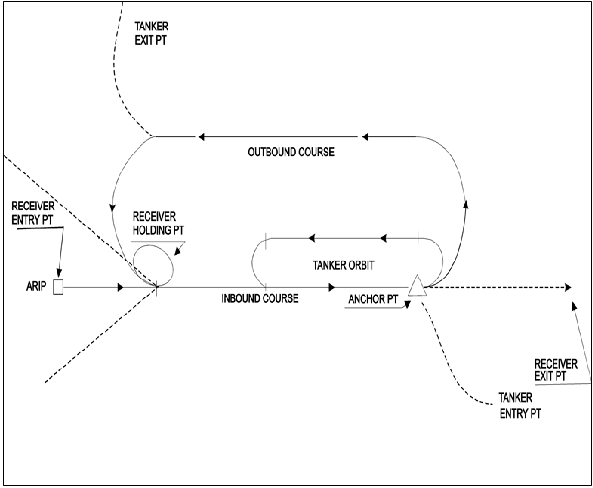Section 3. Anchor Requirements
- The standard aerial refueling anchor track consists of a left-hand race track orbit with legs at least 50 NM in length. The legs will normally be separated by at least 20 NM. The orientation of the track is determined based on the inbound course to the anchor point. Four turn points are designated to describe the anchor track. (See FIG 5-3-1.)
NOTE-
An anchor track may be designed with legs greater than or less than 50 NM in length provided all parties agree that the length is sufficient for the proposed operation and that the refueling operation can safely be conducted within the confines of the anchor area.
- The standard anchor area consists of one or more entry points, an ARIP, anchor point, anchor track turn points, one or more exit points, and the designated refueling altitude block(s).
- Instructions for preparing and submitting anchor proposals are contained in section 4 of this chapter.
Anchor refueling must take place along the published anchor track unless otherwise coordinated with the ARTCC/CERAP/HCF or through a letter of agreement with the controlling agency. Navigation must be accomplished predicated on one of the following:
NOTE-
Clearance into an anchor area does not give aircraft on the anchor track the ATC assigned airspace (ATCAA) that may be associated with the anchor area.
- NAVAIDs while within usable range.
- Airborne equipment utilizing geographical coordinates in remote areas without NAVAID reference.
- Radar service provided by a military radar unit either ground-based or airborne.
- Airborne radar as a secondary operation within the anchor area.
The anchor ARIP must be established:
- Normally, a minimum of 70 NM from the anchor point and within 30 degrees either side of the extended anchor point leg at the uptrack end of the anchor track.
- So as to provide for straight-line navigation from the ARIP to the anchor point leg at the uptrack end of the anchor track.
NOTE-
Receiver entry at ARIP is not required when random rendezvous procedures have been coordinated prior to track/anchor entry and approved by the tanker commander. All maneuvers required to effect rendezvous must be contained within designated airspace.
Anchors predicated on degree-distance definition must provide:
- A means of navigation from the anchor ARIP to the anchor point via a usable NAVAID radial/distance.
- A means of navigation from the exit point of the anchor area to proceed IFR en route via a usable NAVAID.
- Anchor areas located over water or in remote areas or beyond the range of fixed NAVAIDs must be predicated on geographical coordinate route definition with suitable navigation means provided by the user command.
FIG 5-3-1
Anchor Track
